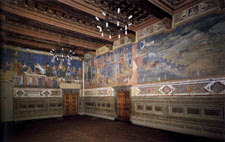
As a Renaissance art historian, I like to think of how contemporary art and exhibitions relate to much earlier examples of art. “Position and Imposition” calls to mind Ambrogio Lorenzetti’s 1338-40 frescoes in the Palazzo Publico in Siena, depicting allegories of good and bad government. So often today people forget the political application of Renaissance art, instead focusing on religious and private examples. Lorenzetti’s frescoes help remind us of how symbiotic the relationship between art and politics has been for centuries.
For more, see Joseph Polzer "Ambrogio Lorenzetti's 'War and Peace' Murals Revisited:Contributions to the Meaning of the 'Good Government Allegory'" Artibus et Historiae, v. 23, no. 45 (2002): 63-105.
[[ Ellen Hurst is a recent transplant from New York City, where she completed coursework towards her Ph.D. in Art History. Her focus area is Art and Architecture of Mediterranean Europe, 1300-1600, and her dissertation will explore the interaction of Italy and Russia in the late-fifteenth and early-sixteenth centuries. She is excited to be joining MCAD this semester. ]]
No comments:
Post a Comment